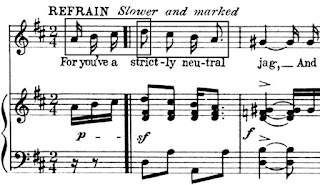The Library of Congress and several other collections have digitized and made available an enormous number of musical compositions published in the United States before 1923. In this series, I will comment on a few with ascending cadence gestures.
Herbert Stothart is well-known as the director of the music department at the MGM studio in the 1930s and 1940s. He came to Hollywood, along with a good many others, from Broadway, where he had established a reputation as an orchestrator and composer by the early 1920s.
The song "Strictly Neutral Jag," co-written with Joseph E. Howard for the show "The Girl of Tomorrow" (1915) in which the song was featured. (All this according to the cover page. I was unable to find anything more on the show. Howard was a Tin Pan Alley composer who wrote "Hello Ma' Baby," among other well-known tunes. Howard's name is listed first on the cover and first page of the score.) The sentiment of the song's subtitle "A Dramatic Appeal with Music" was for American neutrality in World War I, by no means an uncommon view in 1915. "Jag," of course is a play on "rag." The music can be found on the Lester Levy Collection website: link.
The opening of the chorus (refrain) sets up an interval frame ^5-^8, both rising and falling (boxed notes).
The potential of this frame is eventually realized in the close. The chorus is not in the familiar 32-bar AABA design: it is a double period whose first unit is a sentence (see the continuation phrase in the example below -- first four bars) and whose second unit (consequent) is expanded by 4 bars -- those extra bars appear in the second example below. As the opening bar above (repeated at the end of the first example below, with ^1) shows, D5 is well defined as a focal note. Scale degree ^2 is reached at the end of the first unit, and I suppose could be called an interruption, but I have become increasingly skeptical of that term and would find neighbor note quite sufficient: so ^1 -- ^2 -- ^1.
In the consequent D5 descends by sequence down to B4 (not A4) and then rises again to C#5-D5 in the cadence.
Chorus ending:


